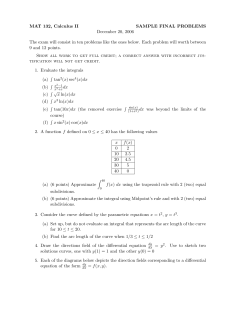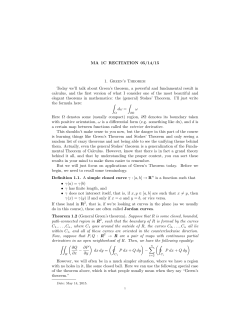
Math 234 Worksheet 4: Line integrals II 1. Do Problem 2 (iii) of
Math 234 Worksheet 4: Line integrals II
1. Do Problem 2 (iii) of Worksheet 3 using Green’s theorem.
2. Let F~ = (−y, x). Let C be the curve x2 + y 2 = 1 oriented counter clockwise.
(i) Sketch the vector field along the curve C.
I
~ ds where N
~ is the outward unit
(ii) Guess what would be the flux
F~ · N
C
normal vector for the curve C.
(iii) Compute the integral with and without Green’s theorem.
~ is the outward unit normal vector for
(iv) Now suppose that F~ = (x, y) and N
H
~ ds ( = , > , < ) 0.
the curve C. Circle one of the followings:
F~ · N
C
3.
(i) Let R be a simply-connected region in the plane and C be the boundary
curve oriented counter clockwise. Show that, by using Green’s theorem,
I
1
−ydx + xdy.
Area of R =
2 C
x 2 y 2
+
= 1 (a, b > 0).
(ii) Compute the area of an ellipse
a
b
Hint: Use the parametrization x = a cos t, y = b sin t.
4. Let R be the region in the first quadrant bounded by x, y axis and the circle
x2 + y 2 = 1 and C be
I the boundary curve of R with the counter clockwise
orientation. Compute
y 3 dx − x3 dy.
C
Review 1 (Flux integral) The flux of a vector field
F~ (x, y) = (P (x, y), Q(x, y))
Z
~ ds. In particular, if C is
~ is defined by
F~ · N
across the curve C in the direction N
C
~ is the outward unit normal vector to the curve C,
oriented counter clockwise and N
~
then N ds = (dy, −dx) and
Z
Z
~
~
F · N ds =
P (x, y)dy − Q(x, y)dx.
C
C
Review 2 (Green’s Theorem) Let R be a simply connected region in the plan, C
~ be the outward
be the boundary curve of R with the counter clockwise orientation, N
~
unit normal vector to the curve C, and F (x, y) = (P (x, y), Q(x, y)). Then
I
Z
ZZ
~
F · d~x =
P (x, y)dx + Q(x, y)dy =
(Qx − Py )dA.
C
C
R
We also have the following equivalent statement for the flux integral
I
ZZ
~
~
F · N ds =
(Px + Qy )dA.
C
R
~ = ( ∂ , ∂ ) and F~ . It is called
Here, note that Px + Qy is fomally the dot product of ∇
∂x ∂y
~
~
~
~
the divergence of F and denoted by ∇ · F or div F .
Answers
1. By Green’s theorem, the line integral is equal to
Z 1Z x
1
ydydx = .
15
0
x2
2.
(i) The vectors should be tangential to the curve C of the same length.
~ are perpendicular at each point on the curve.
(ii) 0, since F~ and N
(iii) Without Green’s theorem: use the parametrization x(t) = cos t, y(t) = sin t
with dx = − sin tdt, dy = cos tdt.
Z
Z
Z 2π
P dy − Qdx =
−ydy − xdx =
− sin t cos tdt − cos t(− sin tdt) = 0.
C
C
0
Let R be the region x2 + y 2 ≤ 1 enclosed by C. Then by Green’s theorem,
Z
ZZ
~
~
~ · F~ dA = 0,
F · N ds =
∇
C
R
~ · F~ = Px + Qy = 0.
since ∇
H
~ ds > 0, since F~ is parallel to N
~.
(iv) C F~ · N
RR
3. (i) Hint: R 1dA = Area of R.
(ii) Ans: πab.
4. Note that R = {(r, θ) : 0 ≤ r ≤ 1, 0 ≤ θ ≤ π/2} in polar coordinates. With
P = y 3 and Q = −x3 , Green’s theorem says that the line integral is equal to
ZZ
ZZ
Z π/2 Z 1
3π
2
2
x + y dA = −3
r2 rdrdθ = − .
(Qx − Py )dA = −3
8
R
0
0
R
2
© Copyright 2025













